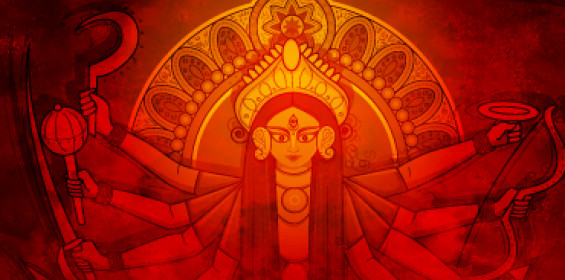Navratri is that time when two seasons meet. In this period of conjunction, limitless powers from the cosmos reach us in the form of energy. Every year, there are two Navratris - Chaitra Navratri and Ashwin Navratri.
Chaitra Navratri marks the beginning of the summer season and Mother Nature undergoes a major climate change. It is a popular belief that during Chaitra Navratri, the body prepares for the upcoming summer season, doing the 'fasting'.
Chaitra Navratri 2020
It starts with the shukla paksha prathama (March 25) and culminates on Ram Navami (April 2), according to the Hindu Lunisolar Calendar.
According to the Ramayana, Lord Rama worshipped Devi Durga in the month of Chaitra. It is believed that the blessings from this worship made him victorious in the battle against Ravana. For this reason, Chaitra Navratri is celebrated grandly all across India, specially in the northern states of Himachal Pradesh, Haryana, Punjab, Madhya Pradesh, Uttar Pradesh and Uttarakhand. In Maharashtra, the festival begins with Gudi Padwa whereas, in southern states like Andhra Pradesh, it starts with Ugadi.
Chaitra Navratri, 2020 - dates & days :
Chaitra Navratri is the most significant Navratri in which all the nine forms of the Divine Mother are worshipped. Each day, one form of Mother Divine is represented and each form is offered prayers, chants, delicious delicacies and prasad.
March 25 - First day (pratipada)
- Devi to be worshipped: Devi Shailputri (the Goddess who is a daughter to the Mountain)
- Prasad to be offered: bananas
- Color: Green
March 26 - Second day
- Devi to be worshipped: Devi Brahmacharini
- Prasad to be offered: ghee made with cow's milk
- Color: Blue
March 27 - Third day (Gauri Tej or Saujanya Teej)
- Devi to be worshipped: Devi Chandraghanta
- Prasad to be offered: salted butter
- Color: Red
March 28: Fourth day (Varad Vinayak Chauth)
- Devi to be worshipped: Devi Kushmanda
- Prasad to be offered: sugar candy
- Color: Orange
March 29: Fifth day (Laxmi Panchami)
- Devi to be worshipped: Devi Skandamata
- Prasad to be offered: rice pudding / milk
- Color: Yellow
March 30: Sixth day (Yamuna Chhat or Skanda Sashthi)
- Devi to be worshipped: Devi Katyayani
- Prasad to be offered: malpua
- Color: Blue
March 31: Seventh day (Saptami)
- Devi to be worshipped: Devi Kaalratri
- Prasad to be offered: honey
- Color: Purple
April 1: Eighth day (Durga Ashtami / Annapurna Ashtami)
- Devi to be worshipped: Devi Mahagauri
- Prasad to be offered: jaggery / coconut
- Color: Pink / Rose
April 2: Ninth day (Navami)
- Devi to be worshipped: Devi Siddhidatri
- Prasad to be offered: wheat flour confection (halwa)
- Color: Gold
Rituals during Chaitra Navratri :
Many devotees observe a fast on all the nine days. Devotees spend their day in worshipping the Divine Mother and chanting the Navratri Mantras.
Did you know?
These goddesses are worshipped:
- Day 1-3: Goddess Durga
- Day 4-6: Goddess Lakshmi
- Day 7-9: Goddess Saraswati
Different aspects of puja
The penultimate wish for any Devi devotee is said to be salvation or moksha. To ready oneself towards that end, certain practices are observed.
Holy pitcher installation: It is considered to be the most important aspect on the initiating day, a symbol of the universe. It is kept at a pious, prayerful place or corner, for the purification and prosperity of the house.
Akand jyot (eternal flame): The light of Navratri is a symbol of peace for the house and family. That is why, it is necessary that before beginning with the navratri puja, you light a traditional ghee lamp. This helps in reducing negative energies of your home and increases mental satisfaction in devotees.
Barley sowing: During Navratri, people sow barley seeds in their homes. It is believed that barley was the first crop of this creation. The first crop in spring is also barley. That is why it is also offered in the Navratri puja havan (sacred puja).

Reading the Durga Saptashati: The Durga Saptashati (Tales of the Mother Divine) is the symbol of prosperity, wealth and peace. During the nine days of Navratri, reading and reciting the Durga Saptashati is considered the most auspicious deed.
Worshipping the girl child: Kanya Pujan (worshipping the girl child) is an important aspect of honoring the Divine Mother (Devi). There is a custom of presenting them with flowers, cardamom, fruits, betel nut, sweets, adornment items, clothes, home-cooked food, especially, halwa, black gram and poori.
COVID-19 & Chaitra Navratri
2020 will see a new kind of Chaitra Navratri celebration. For the first time possibly, temples may be closed to the public; large masses of people will not gather for satsangs and pujas. Social distancing is, perhaps, a kind of prayer too this time.
- If you’re missing the gaiety and buzz of festivities, here’s a little something for you:
- Continue your reading of the Devi Mahatmya or any other scripture you choose.
- Make a playlist of your favorite Devi chants and bhajans, so you don’t miss the regular satsangs.
- Listen to Devi Kavacham daily.
- Spend some time every day in silence and meditation. It is said that meditation is the highest kind of prayer.
- If you’re unable to procure some of your regular puja materials, it’s alright. The Devi is still happy with you.
- Use the power of technology and invite friends and family for regular chanting and meditation. Have a virtual / online satsang!
- This Chaitra Navratri, make your mind into a temple!
Some special rules for the rituals:
1. Praying and fasting are the epitome of the Chaitra Navratri festival. Before the beginning of the festivities, people deep-clean their houses to welcome the Mother Divine.
2. Many people choose to observe certain practices such as
- sleeping on the floor
- eating light and sattvik food (example: buckwheat flour, curd, fruits)
- remaining celibate
- spending time in satsangs, meditation and knowledge
- do not use leather
- observe silence
- practice self-awareness and not indulge in anger, greed
- listen to chanting such as Devi Kavacham
Recommended reads:
- Navdurga
- Significance of the chant: Yaa Devi Sarva
- Lalitha Sahasranama
- Durga Saptashati - introduction
- Devi Mahatmyam Voyage towards a fully blossomed self
- Top 10 Art of Living Devi bhajans





























